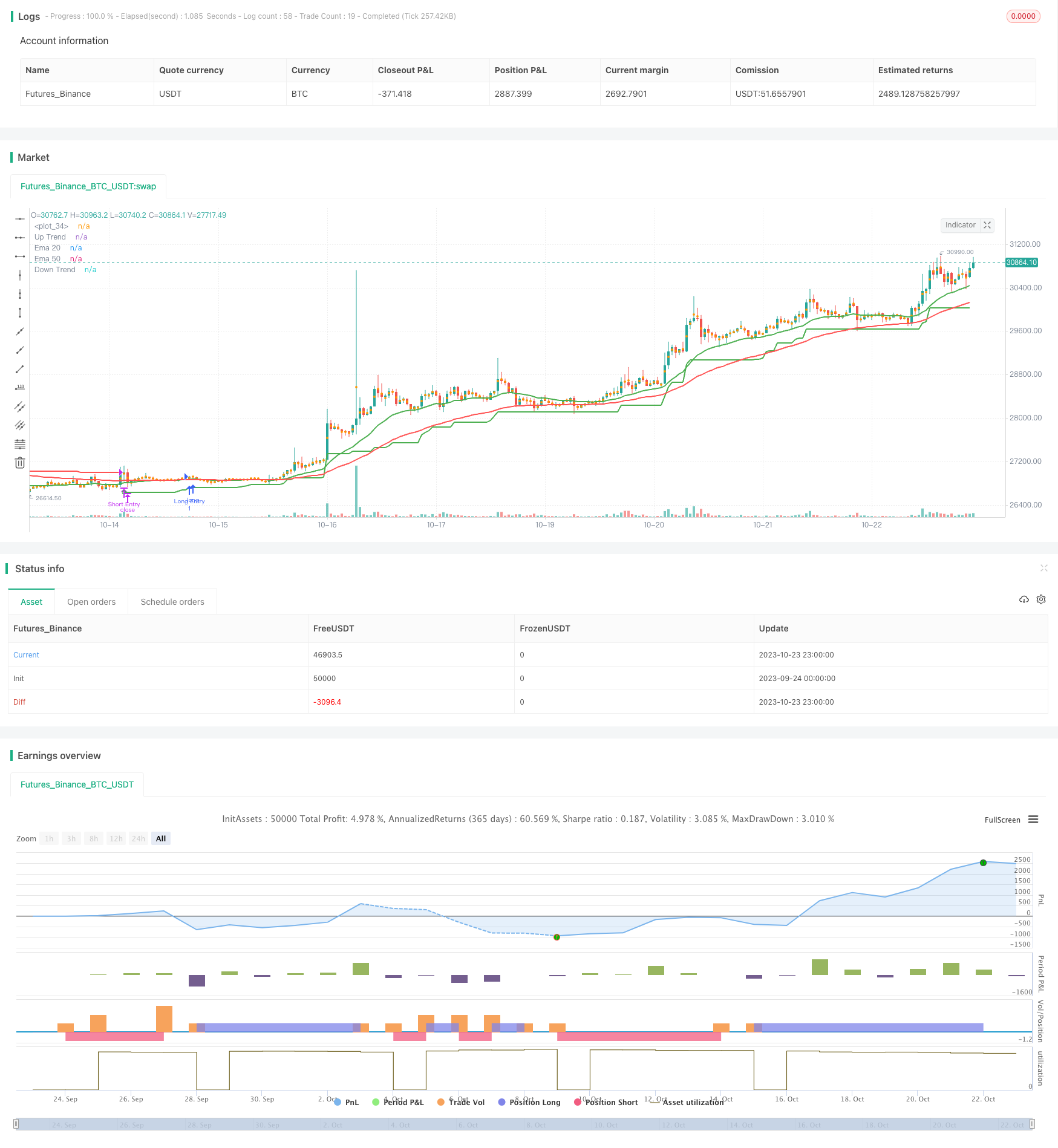
概述
EMA交叉策略通过追踪两个不同周期的EMA均线的交叉情况,判断价格趋势从而产生买入和卖出信号。当短周期EMA上穿长周期EMA时产生买入信号,当短周期EMA下穿长周期EMA时产生卖出信号。该策略同时结合SuperTrend指标过滤假突破。
策略原理
该策略主要基于EMA均线的金叉死叉原理。EMA均线能够平滑价格数据过滤噪音,通过EMA均线的交叉情况判断价格趋势。当短周期EMA(20周期)上穿长周期EMA(50周期)时,代表短周期价格现在位于长周期价格之上,说明价格存在突破上升趋势,产生买入信号。当短周期EMA下穿长周期EMA时,代表短周期价格跌破长周期价格,说明价格存在下跌趋势,产生卖出信号。
同时,该策略结合SuperTrend指标来过滤EMA交叉产生的假信号。SuperTrend指标是根据ATR计算出的上轨和下轨,可以更准确判断真实趋势。当价格突破SuperTrend指标的上轨时产生买入信号,当价格跌破SuperTrend指标下轨时产生卖出信号。只有在SuperTrend指标也同时产生买入/卖出信号时,EMA交叉才会产生真正的交易信号。这可以过滤由于价格震荡而产生的EMA交叉假信号。
具体来说,该策略判断条件如下:
当20EMA上穿50EMA,且价格突破SuperTrend上轨时,产生买入信号;
当20EMA下穿50EMA,且价格跌破SuperTrend下轨时,产生卖出信号。
通过EMA交叉判断大趋势,同时结合SuperTrend指标过滤震荡,可以提高策略交易信号的准确率。
优势分析
EMA交叉策略具有以下优势:
操作简单,易于实现。仅需要计算两个EMA均线的交叉情况。
对价格震荡有一定的过滤作用。EMA作为移动平均线,能够过滤掉部分噪音。
结合SuperTrend指标,可以进一步过滤噪音,减少假信号。
可以通过调整EMA周期参数,适应不同市场环境。
可自定义长短仓位,可实现多种交易方式。
可在不同时间周期上实现,适用于不同型交易者。
风险分析
EMA交叉策略也存在一些风险:
当市场出现剧烈波动时,EMA交叉signals可能滞后,无法及时反映价格变化。
EMA均线具有滞后性,可能产生错误信号。
短周期EMA和长周期EMA参数设置不当,可能导致产生过多错误信号。
单纯依靠均线交叉无法确定市场实际趋势,存在一定盲目性。
需要选择合适的止损策略控制风险。
以下几点可以降低风险:
优化EMA周期参数,选择合适的快慢均线周期。
适当缩短持仓时间,及时止损。
结合其它指标如移动平均线、K线形态等进行综合判断。
适当调整交易频率,降低交易次数。
优化方向
该策略可以从以下几个方面进行优化:
优化EMA均线的周期参数,适应不同周期和市场环境。可以引入自适应参数优化机制。
尝试不同的均线指标,如SMA,KWMA等。
结合更多指标进行组合交易,形成多因子模型。如MACD,RSI等。引入机器学习算法进行参数优化和权重调整。
增加止损策略,如跟踪止损,百分比止损等来控制风险。
引入交易量过滤,结合交易量指标避免虚假信号。
优化策略 exits,设定离场规则。如结合K线形态,突破等 EXIT signals。
在较高时间周期确认趋势,在较低时间周期入场,实现趋势跟踪。
总结
EMA交叉策略是一种简单实用的趋势跟踪策略。它能够识别价格中期趋势,产生买入卖出timing信号。结合SuperTrend指标可以有效过滤噪音,减少错误trades。但该策略依然存在滞后,产生错误信号的风险。通过参数优化,止损,组合其他指标等方式可以增强策略效果。EMA交叉策略易于操作SIMPLE,适合跟踪中长线趋势,是一种适合新手交易者的有效策略。
/*backtest
start: 2023-09-24 00:00:00
end: 2023-10-24 00:00:00
period: 1h
basePeriod: 15m
exchanges: [{"eid":"Futures_Binance","currency":"BTC_USDT"}]
*/
// This source code is subject to the terms of the Mozilla Public License 2.0 at https://mozilla.org/MPL/2.0/
// © alokbothra
//@version=5
strategy("Ema Crossover", overlay=true, initial_capital = 1000)
start = timestamp(2021,1,1,0,0)
end = timestamp(2023,10,30,0,0)
plot (ta.ema(close,20), title = "Ema 20", color = color.green , linewidth = 2)
plot (ta.ema(close,50), title = "Ema 50", color = color.red, linewidth = 2 )
//supertrend 1
Periods = input(title='ATR Period', defval=11)
Multiplier = input.float(title='ATR Multiplier', step=0.1, defval=3)
changeATR = input(title='Change ATR Calculation Method ?', defval=true)
showsignals = input(title='Show Buy/Sell Signals ?', defval=true)
highlighting = input(title='Highlighter On/Off ?', defval=true)
atr2 = ta.sma(ta.tr, Periods)
atr = changeATR ? ta.atr(Periods) : atr2
up = close - Multiplier * atr
up1 = nz(up[1], up)
up := close[1] > up1 ? math.max(up, up1) : up
dn =close+ Multiplier * atr
dn1 = nz(dn[1], dn)
dn := close[1] < dn1 ? math.min(dn, dn1) : dn
trend = 1
trend := nz(trend[1], trend)
trend := trend == -1 and close > dn1 ? 1 : trend == 1 and close < up1 ? -1 : trend
upPlot = plot(trend == 1 ? up : na, title='Up Trend', style=plot.style_linebr, linewidth=2, color=color.new(color.green, 0))
buySignal = trend == 1 and trend[1] == -1
plotshape(buySignal ? up : na, title='UpTrend Begins', location=location.absolute, style=shape.circle, size=size.tiny, color=color.new(color.green, 0))
dnPlot = plot(trend == 1 ? na : dn, title='Down Trend', style=plot.style_linebr, linewidth=2, color=color.new(color.red, 0))
sellSignal = trend == -1 and trend[1] == 1
plotshape(sellSignal ? dn : na, title='DownTrend Begins', location=location.absolute, style=shape.circle, size=size.tiny, color=color.new(color.red, 0))
mPlot = plot(ohlc4, title='', style=plot.style_circles, linewidth=0)
changeCond = trend != trend[1]
longonly = input.bool(defval = true, title = 'Long Only')
shortonly = input.bool(defval = true, title = 'Short Only')
longCondition = (ta.ema(close, 20) >= ta.ema(close, 50))
shortCondition = (ta.ema(close, 20) <= ta.ema(close, 50))
long = (trend == 1)
short = (trend == -1)
sell= short
cover= long
if time >= start and time < end
if longonly
if ((longCondition) and (long))
strategy.entry ("Long Entry", strategy.long, comment ="Long Entry")
if strategy.position_size > 0
strategy.close("Long Entry", when = sell, comment = "Long Exit")
if shortonly
if ((shortCondition) and (short))
strategy.entry("Short Entry", strategy.short, comment = "Short Entry")
if strategy.position_size < 0
strategy.close("Short Entry", when = cover, comment = "Short Exit")